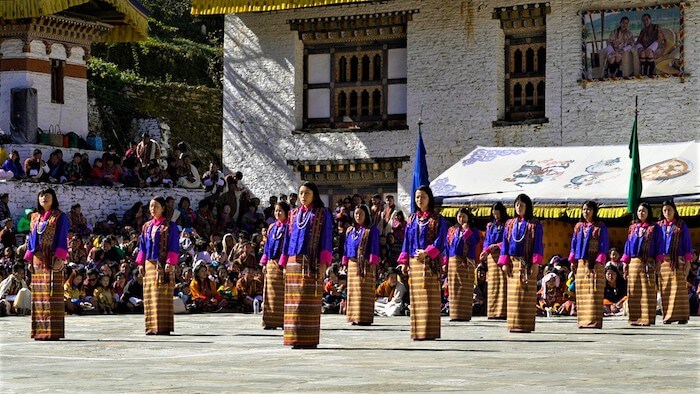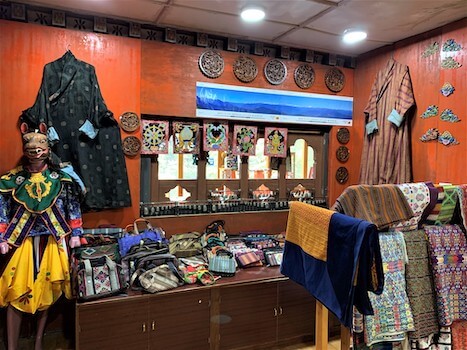 In the high Himalayan Mountains, colours take on an intensity and beauty that often seems to the observer almost unreal. The deep green of the valleys and hillsides, the vivid blue of the rivers and sky, the white of the snow above the brown/gold alpine pastures – all this is the backdrop of the Bhutanese artist’s work. On them the artists place a myriad of colours that spring not only from the stimulus of nature but also from the religious heritage. In Himalayan Buddhism, contemplation and visualization of colours is an integral part of meditation and worship, bringing the believer closer to the goal of enlightenment. The transcendental reality too is believed to be experienced in the form of different components of light. From the mystic pattern of mandala to the swirling skirts of the festival dancers, to the ornate galleries of the Dzongs, artists of Bhutan celebrate colour in its most vivid and expressive forms.
In the high Himalayan Mountains, colours take on an intensity and beauty that often seems to the observer almost unreal. The deep green of the valleys and hillsides, the vivid blue of the rivers and sky, the white of the snow above the brown/gold alpine pastures – all this is the backdrop of the Bhutanese artist’s work. On them the artists place a myriad of colours that spring not only from the stimulus of nature but also from the religious heritage. In Himalayan Buddhism, contemplation and visualization of colours is an integral part of meditation and worship, bringing the believer closer to the goal of enlightenment. The transcendental reality too is believed to be experienced in the form of different components of light. From the mystic pattern of mandala to the swirling skirts of the festival dancers, to the ornate galleries of the Dzongs, artists of Bhutan celebrate colour in its most vivid and expressive forms.
Bhutanese art is rarely random. Rather its forms and patterns are dictated by age-old credos. Its impulse is primarily spiritual, the belief that to create tributes to the deities – whether in painting, sculpture, architecture, dance or song – is a pious act. Creations of the artists are in this context far from being solely aesthetic but rather aids to devotion and to a fuller understanding of the tenets of Buddhism. Thus, over the centuries, the Bhutanese have synthesised many artistic traditions – Indian, Nepalese, Chinese, Tibetan, Central Asian – and wrought from them a style that is uniquely their own.
Visual Arts
The mandala is a favourite subject – In its simplest form, this mystic pattern, through which the individual is brought into harmony with the universe around him, is traced out in coloured powders or rice to celebrate a particular occasion. In its more elaborate and complex form, the mandala adorns the walls and ceilings of temples and shrines or is painted, embroidered or appliqued on the scrolls known as Thangkhas. Many of these delicate murals made of cotton or canvas framed with silk or brocade are displayed only on special occasions only for a short time, blessing all who look upon them. One of the most popularly depicted figures is Guru Padmasambhava, who brought Buddhism to Bhutan and in his many different manifestations, showed the people the path to salvation.
Another popular theme is the eight auspicious signs, the 'Tashi Tagye'. Corresponding to different parts of the body of Buddha, these represent the qualities that are essential steps to enlightenment, symbolized by a lotus flower. The Tashi Tagye decorate not only the holy places but also the doors and windows of houses and public buildings.
 Crafts
Crafts
The skill of Bhutanese craftsmen in working with bronze, silver and other fine metal is seen in a multitude of ways: statues of deities, doors and pillars of temples, bells, trumpets, tables, rice boxes, jewellery etc. Sculpture of religious figures is widely practised and every temple contains large, brightly painted and gilded statues of Buddha and saints. Mythological figures, many recalling the shamanism of pre-Buddhist times are stylized in the masks – fashioned from paper mache, clay and wood – that are used, to startling effect, in religious dances.
Wooden crafts include bowls and dishes and a wealth of items made from finely worked bamboo, among them hats, baskets, butter containers, bows and arrows are the main ones. Handmade paper is produced from the bark of trees as it was centuries ago when the Bhutanese were renowned for the beauty of their calligraphy. Some of these precious manuscripts, well preserved, still exit.
Dance
Amongst the Himalayas, the ancient dances of the region have been most faithfully preserved in Bhutan. The extraordinary grace and colour of these energetic, dramatic dances is one of the visitors’ most vivid memories. To the fanfare of trumpets and the rhythmic sound of drums, cymbals, pipes and gongs, a rainbow of dancers whirl and bends and leaps high in the air, skirts swirling and hands moving in the timeless gestures that correspond to the mudras of Buddhist ceremonies. Here are the tales and legends of Buddhist history, mythology. Heroes vanquish demons, believers drive out non-believers.
Dancing is the centre of all religious festivals. Stag dancers portray the demons of old, cemetery dancers remind that life is transient and the search of worldly pleasure illusory, hero dancers piercing the cloud of ignorance with their swords assure spectators that good works will help them achieve a favourable rebirth.
Music
Folk songs of an itinerant minstrel, the low chanting of monks, the sound of longs horns echoing across the valley, of lively processions and sacred dances, of ancient folk dramas enacted – these are all part of the intriguing pastiche of Bhutanese music. The Bhutanese are musical people and here as in dances, many of the most ancient forms have been resolutely preserved. The instruments have sometimes been modified but the sound, the beautiful often haunting effect remains as it was many centuries ago. Among the instruments used are the gyaling, shawm; dung-kur, conch-shell trumpets; dung-chen, long trumpets; nga-bom, large drums; sil-nyen, large cymbals with a shallow bass; damaru or tantri, an hour-glass pellet drums; and drib, a small hand-bell.